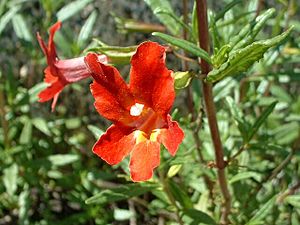Sticky monkey-flower facts for kids
Quick facts for kids Sticky monkey-flower |
|
|---|---|
 |
|
| Scientific classification | |
| Genus: |
Diplacus
|
| Species: |
aurantiacus
|
| Synonyms | |
|
|
The sticky monkey-flower, also called the orange bush monkey-flower, is a beautiful plant found in North America. Its scientific name is Diplacus aurantiacus. This plant grows like a small bush and is native to places like southwestern Oregon and most of California. It belongs to a plant family called Phrymaceae. Long ago, it was known by a different name, Mimulus aurantiacus.
Contents
What Does the Sticky Monkey-Flower Look Like?
The sticky monkey-flower can grow up to 1.2 meters (about 4 feet) tall. It has bright green leaves that feel a bit sticky. These leaves are usually 3 to 7 centimeters long.
Its Amazing Flowers
The plant's flowers are shaped like tubes at the bottom. They are about 2 centimeters long and have five wide petals. You can find these flowers in many colors, from white to red. The most common color is a bright orange.
How Does It Get Pollinated?
Sticky monkey-flowers are important "honey plants." This means they produce nectar that attracts pollinators. Bees and hummingbirds love to visit these flowers. They help the plant make seeds by moving pollen from one flower to another.
Where Does It Grow?
This plant is very tough! It can grow in many different climates. It also does well in various types of soil, whether it's wet, dry, sandy, or rocky. It can even grow in serpentine soil. This type of soil is usually hard for most plants because of its unique minerals.
Why Is It Sticky?
The leaves of the sticky monkey-flower have a special sticky substance. This substance helps the plant hold onto water. This is very helpful in dry places. It also helps protect the plant from some insects that might want to eat its leaves.
A Home for Butterflies
Even with its sticky leaves, the sticky monkey-flower is a very important plant for certain butterflies. It is a host plant for the larvae (caterpillars) of the common buckeye butterfly and the variable checkerspot butterfly. These caterpillars eat the leaves to grow.
Growing Sticky Monkey-Flowers in Gardens
This plant is an evergreen shrub, meaning it keeps its leaves all year. People often grow it in gardens that use less water. It is also popular in native plant gardens and habitat gardens. These gardens try to use plants that are natural to the area.
Growing in Colder Places
The sticky monkey-flower does not like freezing temperatures. In places where it gets very cold, people often grow it indoors or in special greenhouses. This helps protect it from the frost. In the UK, this plant has even won a special award called the Royal Horticultural Society's Award of Garden Merit.
Traditional Uses by Native Americans
Long ago, Miwok and Pomo Native Americans used the sticky monkey-flower. They used parts of the plant to help treat small problems like sores, burns, and eye irritation. They also used the colorful flowers for decoration.
Images for kids







